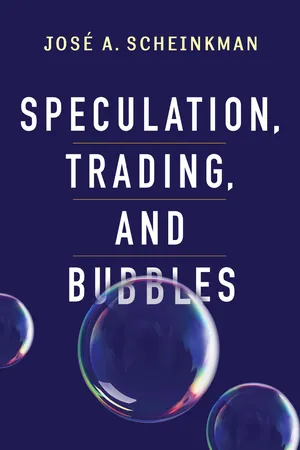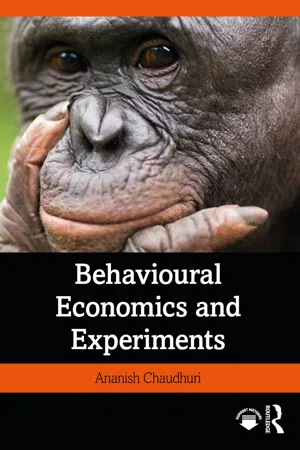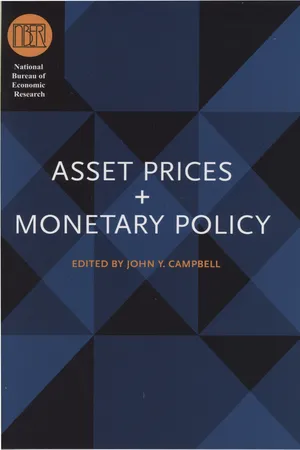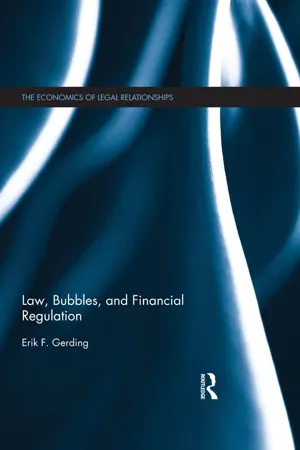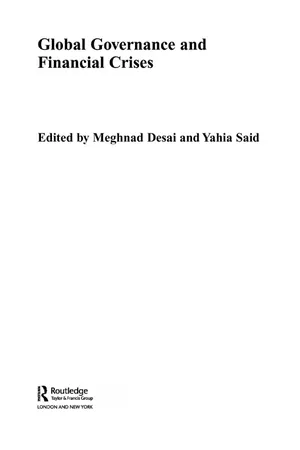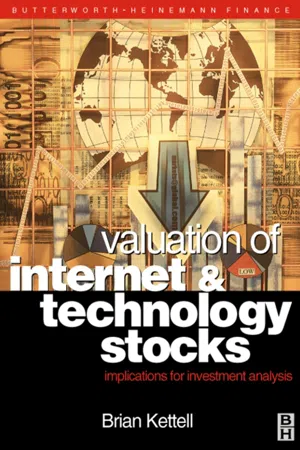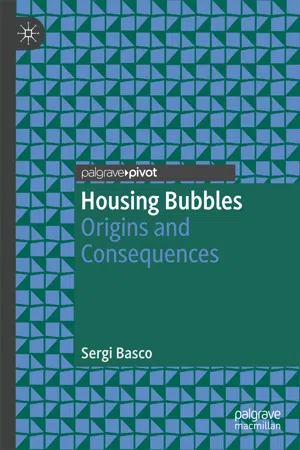Economics
Asset Price Bubble
An asset price bubble refers to a rapid and unsustainable increase in the prices of assets, such as stocks, real estate, or commodities, driven by speculation rather than intrinsic value. These bubbles often lead to inflated asset prices that eventually collapse, causing significant economic disruption. Central banks and policymakers closely monitor asset price bubbles to mitigate their potential negative impact on the economy.
Written by Perlego with AI-assistance
Related key terms
1 of 5
11 Key excerpts on "Asset Price Bubble"
- Available until 27 Jan |Learn more
- José A. Scheinkman, Kenneth J. Arrow, Patrick Bolton, Joseph E. Stiglitz, Sanford J. Grossman(Authors)
- 2014(Publication Date)
- Columbia University Press(Publisher)
SPECULATION, TRADING, AND BUBBLESJOSÉ A. SCHEINKMAN*T he history of financial markets is strewn with periods in which asset prices seem to vastly exceed fundamentals—events commonly called bubbles. Nonetheless, there is very little agreement among economists on the economic forces that generate such occurrences. Numerous academic papers and books have been written explaining why the prices attained in a particular episode can be justified by economic actors rationally discounting future streams of payoffs. Some proponents of the efficient-markets theory even deny that one can attach any meaning to bubbles.1Part of the difficulty stems from the fact that economists’ discussions of bubbles often concentrate solely on the behavior of asset prices. The most common definition of a bubble is “a period in which prices exceed fundamental valuation.” Valuation, however, depends on a view of fundamentals, and efficient-market advocates correctly point out that valuations are almost always, ex post, wrong. In addition, bubbles are frequently associated with periods of technological or financial innovations that are of uncertain value at the time of the bubble, making it possible, although often unreasonable, to argue that buyers were paying a price that corresponded to a fair valuation of future dividends, given the information at their disposal.In this lecture I adopt an alternative approach. I start with a more precise model of asset prices that allows for divergence between asset prices and fundamental valuation and that has additional implications that are easier to evaluate empirically. The model is based on the presence of fluctuating heterogeneous beliefs among investors and the existence of an asymmetry between the cost of acquiring an asset and the cost of shorting that same asset. The two basic assumptions of the model—differences in beliefs and higher costs of going short—are far from being standard in the literature on asset pricing. For many types of assets, including stocks, there are good economic reasons why investors should have more difficulty going short than going long, but most economic models assume no asymmetry. The existence of differences in beliefs is thought to be obvious for the vast majority of market practitioners, but economists have produced a myriad of results showing that investors cannot agree to disagree. One implication of “cannot agree to disagree” results is that differences in private information per se do not generate security transactions, since agents learn from observing security prices that adjust to reflect the information of all parties. Arrow (1986) appropriately calls this implication “[a conclusion] flatly contrary to observation.”2 - eBook - ePub
- Ananish Chaudhuri(Author)
- 2021(Publication Date)
- Routledge(Publisher)
Extraordinary Popular Delusions and the Madness of Crowds by the British journalist, Charles Mackay. Tulips were probably introduced to Europe in the middle of the 16th century from Turkey. They were different from other European flowers and quickly became a status symbol. As the flowers grew in popularity, professional growers paid higher and higher prices for bulbs and prices rose steadily. By 1636, tulip bulbs became one of the Netherlands’ leading exports. The price of tulips skyrocketed because of speculation in tulip futures among people who never saw the bulbs. Tulip mania reached its peak during the winter of 1636–1637, when some bulbs were reportedly changing hands ten times in a day. The collapse began when buyers refused to show up at a tulip bulb auction in Haarlem, which was suffering from an outbreak of bubonic plague. This outbreak might also have helped to burst the bubble.Studying asset bubbles in the lab
An asset or price bubble is a situation where the price of an asset far exceeds the asset’s fundamental value. For instance, consider a house. The price of the house should reflect the value of the land on which the house stands as well as the total cost of the building itself. While there is certainly scope for differences in valuation and, therefore, some deviation in the price of the house from its underlying value, these deviations should not be huge, and, in any event, should not persist for long periods of time. A similar argument is true of shares in a company. The current price of the share should reflect the risk adjusted discounted value of expected future dividends to be paid on it.5 So, the current price should subsume all the relevant information and this price should not change unless something fundamental changes about the company, people’s expectations or the market conditions. This, in turn, implies that prices should track the fundamental value closely and that it should be difficult to “beat the market” by buying and selling such shares. If all traders are perfectly rational and equally well informed about the market conditions, then they should all price the share in a similar way. This idea that prices of financial assets such as shares should track the fundamental value is the essence of the efficient markets hypothesis , as proposed by Eugene Fama of the University of Chicago in the 1970s.But, as we know now, not everyone is rational, or at least not rational to the same extent. They are also not equally well informed and, more importantly, we know that people are subject to a wide range of biases. All of these suggest that, while the efficient markets hypothesis may be an elegant theory, in practice this may not quite hold. But there are problems in trying to understand bubble formation in markets with naturally occurring data on prices and quantities. For one thing, it is not always obvious when a bubble is forming due to speculative frenzy as opposed to shifts in underlying demand and supply conditions. It is also not always easy to separate the price dynamics from other potential confounds. - eBook - ePub
A History of Financial Crises
Dreams and Follies of Expectations
- Cihan Bilginsoy(Author)
- 2014(Publication Date)
- Routledge(Publisher)
6 Explaining asset-price bubbles and banking crises DOI: 10.4324/9781315780870-6In his Memoirs of Extraordinary Popular Delusions and the Madness of Crowds Scottish journalist Charles Mackay (2009 [1852]) describes tulip mania, the Mississippi Bubble, and the South Sea Bubble as collective delusions spread across all ranks of society. The same state of mind and herd mentality that tempted people to participate in witch hunts and apocalyptic fantasies, which are among the vignettes that Mackay portrays, was evident in the rush to buy assets with dreams of getting rich(er) overnight. Popular songs, allegorical prints, and sarcastic poems that proliferated at the peak and during the aftermath of these episodes also painted pictures of out-of-control greed and a populace devoid of common sense. While these descriptions are amusing and commonplace, they fall short of explaining why bubbles emerge. Their frequent embellishments also provide an easy foil for commentators who dispute the verisimilitude of the historical accounts. Between the two perceptions of the human condition, i.e. individual optimization under competitive conditions that rules out bubbles, and the collective frenzy that makes them ubiquitous, there is a diverse set of theories that acknowledge the existence of bubbles. These theories attempt either to reconcile bubbles with the canons of the standard economic theory or search for explanations based on alternative behavioral foundations or evolutionary capitalist market dynamics.This chapter is an introduction to the theories of financial crises. It will focus mainly on asset-price bubbles and, to a lesser extent, on banking crises. I classify the competing hypotheses into five categories. First, the orthodox, fundamentals-based approach is characterized by optimizing agents who operate in perfectly competitive markets. Each economic agent is an independent decision maker, guided by the available information on the fundamentals. Consequently, the fundamental and market prices are identical, and the bubble is just an economic myth. The second category accepts the primacy of the fundamentals but recognizes the possibility of asset-price bubbles. Its explanation for bubbles is that government-policy interventions in the economy distort relative prices and create deviations from the fundamentals. The third category tweaks the orthodoxy. It retains the optimization postulate but recognizes bubbles and banking crises as possible outcomes of pervasive imperfections and frictions in the market. The fourth category replaces the optimization postulate with behavioral foundations of decision-making. Bubbles are outcomes of the interaction of non-optimizing decision-making with social and psychological dynamics. The fifth category focuses on institutional characteristics of capitalist economies and concludes that financial crises that feature manias and panics are endemic to the evolution of competition and the credit cycle in a loosely regulated financial sector. This chapter presents each approach and illustrates it in the context of the classical bubble episodes. - eBook - PDF
- John Y. Campbell(Author)
- 2008(Publication Date)
- University of Chicago Press(Publisher)
In sum, asset prices influence the economy in complex and subtle ways over potentially ex-tended periods of time. Finally, I think it fair to say that most central banks, faced with only a limited understanding of asset prices and their interactions with the full economy, engage in a form of risk management when dealing with market booms and busts. In part, they do this because any particular policy under consideration is never associated with a single forecast for the future paths of output and inflation but, instead, with a large set of possible scenarios with di ff ering odds of coming to pass. Most policymakers engage in at least an informal weighing of these various possibilities and their implications when setting policy. Now let me turn from areas of agreement to more contentious issues. As I see it, extra action pays only if three tough conditions are met. First, pol-icymakers must be able to identify bubbles in a timely fashion with reason-able confidence. Second, there must be a fairly high probability that a mod-estly tighter policy will help to check the further expansion of speculative activity. And finally, the expected improvement in future economic perfor-mance that would result from a less expansive bubble must be sizable. For the moment, let me set aside the first condition and assume that cen-tral banks can distinguish an emerging bubble from improving fundamen-tals at an early stage. Should we presume that a limited application of re-strictive policy would materially restrain the speculative boom and make its eventual unwinding less disruptive for the overall economy? Consider the U.S. stock market boom of the mid-to-late 1990s. The boom was fueled by a sustained acceleration of productivity and an ac-companying rise in corporate profits—fundamental changes that justified a major rise in equity prices. - eBook - ePub
- Erik F. Gerding(Author)
- 2013(Publication Date)
- Taylor & Francis(Publisher)
Manias, Panics and Crashes: A History of Financial Crises, 16 (4th ed. 2000, Wiley Investment Classics) (defining a bubble as “an upward price movement over an extended range that then implodes”).2 See, e.g., Robert P. Flood and Peter M. Garber, Market Fundamentals Versus Price-Level Bubbles: The First Tests, 88 Journal of Political Economy 745, 746 (1980); Henry T. C. Hu, Faith and Magic: Investor Beliefs and Government Neutrality, 78 Texas Law Review 777, 794 (2000). At times, economists have expanded this basic definition to include the reason that asset prices diverge from their fundamental values. Markus K. Brunnermeier, Bubbles, in The New Palgrave Dictionary of Economics (Steven Durlauf and Lawrence Blume eds., 2008, Palgrave Macmillan) (“Bubbles refer to asset prices that exceed an asset’s fundamental value because current owners believe that they can resell the asset at an even higher price in the future.”).3 See, e.g., Ellen R. McGrattan and Edward C. Prescott, Testing for Stock Market Overvaluation/Undervaluation, in Asset-Price Bubbles: The Implications for Monetary, Regulatory, and International Policies, 271 (William C. Hunter, George G. Kaufman, and Michael Pomerleano, eds., 2003, MIT Press) [hereinafter Asset Price Bubbles]. One alternative to defining fundamental value in terms of future cash flows is to say that the best guess as to fundamental value is whatever the market price is. That tautology would make it impossible for prices ever to be “wrong.”4 For a primer on bond valuation, see A. A. Groppelli and Ehsan Nikbakht, Finance, 119–22 (5th ed. 2006, Barron’s Educational Series).5 See, e.g., Kenneth A. Froot and Maurice Obstfeld, Intrinsic Bubbles: The Case of Stock Prices, 81 American Economic Review - eBook - ePub
- Meghnad Desai, Yahia Said, Meghnad Desai, Yahia Said(Authors)
- 2003(Publication Date)
- Routledge(Publisher)
3 Asset Price Bubbles and monetary policyFranklin Allen and Douglas GaleIntroduction
The idea that the amount of money and credit available is an important factor in the determination of asset prices is not new. In his description of historic bubbles Kindleberger (1978, p. 54) emphasizes the role of this factor: “Speculative manias gather speed through expansion of money and credit or perhaps, in some cases, get started because of an initial expansion of money and credit.”In many recent cases where asset prices have risen and then collapsed dramatically, an expansion in credit following financial liberalization appears to have been an important factor. Perhaps the best-known example of this type of phenomenon is the dramatic rise in real estate and stock prices that occurred in Japan in the late 1980s and their subsequent collapse in 1990. Financial liberalization throughout the 1980s and the desire to support the US dollar in the latter part of the decade led to an expansion in credit. During most of the 1980s asset prices rose steadily, eventually reaching very high levels. For example, the Nikkei 225 index was around 10,000 in 1985. On December 19, 1989 it reached a peak of 38,916. A new Governor of the Bank of Japan, less concerned with supporting the US dollar and more concerned with fighting inflation, tightened monetary policy and this led to a sharp increase in interest rates in early 1990 (see Frankel 1993; Tschoegl 1993). The bubble burst. The Nikkei 225 fell sharply during the first part of the year and by October 1, 1990 it had sunk to 20,222. Real estate prices followed a similar pattern. The next few years were marked by defaults and retrenchment in the financial system. The real economy was adversely affected by the aftermath of the bubble and growth rates during the 1990s have mostly been slightly positive or negative, in contrast to most of the postwar period when they were much higher. - eBook - PDF
Valuation of Internet and Technology Stocks
Implications for Investment Analysis
- Brian Kettell(Author)
- 2002(Publication Date)
- Butterworth-Heinemann(Publisher)
But before we proceed further, we first of all need to describe the terminology used by ‘bubbleologists’. Bubble terminology Following the technical language of economics, a ‘bubble’ is any deviation from ‘fundamental values’, whether up or down. Fundamental values are a concept easier to define in theory than in practice. This concept refers to the prices stocks ought to sell for based on business’s real economic value, apart from speculation. The assumption is that stock prices will ultimately (whenever that is) return to their fundamental values, however much extraneous factors may be influencing them at any one moment. A bubble is an upward price movement over an extended range which then implodes. An extended negative bubble is a crash. ‘Noise’ refers to small price variations about fundamental values. So a bubble is a situation in which the price of an asset differs from its fundamental market value. With a rational bubble, as discussed below, investors can have rational expec-tations that a bubble is occurring because the asset price is above its fundamental value but they continue to hold the asset anyway. They might do this because they believe that someone else will buy the asset for a higher price in the future. In a Bubbleology, stock markets and the Internet and technology stock price collapse 111 rational bubble, asset prices can therefore deviate from their fundamental value for a long time because the bursting of the bubble cannot be predicted and so there are no unexploited profit opportunities. When a stock is experiencing a rational bubble, the rate of return on an asset is higher than normal in order to com-pensate the holder for the possibility that the asset’s price might suddenly collapse to its fundamental value. With what is known as a rational bubble, the asset holder is willing to accept a lower rate of return since the asset’s price might suddenly jump up to its fundamental value. - International Monetary Fund. Research Dept.(Author)
- 2002(Publication Date)
- INTERNATIONAL MONETARY FUND(Publisher)
The long bull market and the exuberance associated with the new economy boom of the 1990s came to a halt in 2000. Since then, broad equity price indices in industrial countries have fallen sharply and persistently. Asset price crashes or busts have often been associated with declines in economic activity, financial instability, and, sometimes, large budgetary costs from the recapitalization of banking systems. However, while many countries have experienced economic slowdowns after the most recent wave of equity price busts, the downturns have not been especially severe. Similarly, while equity prices have fallen by large amounts, financial institutions’ health in many countries has (so far) turned out to be relatively resilient. Looking forward, what does the post-equity-bubble environment imply for the buoyancy of consumption, the recovery of investment, and the strength of housing prices?To shed light on the relationships between asset price busts and macroeconomic and financial fluctuations, this essay describes the main empirical regularities across industrial countries over the past four decades. The appropriate conduct of monetary policy during an asset price boom will not be addressed, as it was dealt with extensively in a recent World Economic Outlook .2 The focus on the stylized facts of asset price busts obviates the need to measure or explain “bubbles,” which—despite the frequent use of the term—remains highly controversial.3- eBook - ePub
Housing Bubbles
Origins and Consequences
- Sergi Basco(Author)
- 2018(Publication Date)
- Palgrave Pivot(Publisher)
© The Author(s) 2018 Sergi Basco Housing Bubbles https://doi.org/10.1007/978-3-030-00587-0_3Begin Abstract3. Origin of Asset Price Bubbles
Sergi Basco1(1) Universitat Autònoma Barcelona, Barcelona, SpainAbstract
The recurrence of Asset Price Bubbles throughout history has stimulated the interest of economists in different generations. We divide theories on the origin of bubbles in two: (i) behavioral and (ii) rational. First, we explain how differences in the beliefs of agents may result in bubbles (behavioral explanation). Second, we discuss how Asset Price Bubbles may emerge because the economy has a shortage of assets (rational explanation). Finally, we develop a simple model to explain how rational housing bubbles may appear in financially underdeveloped economies.End AbstractKeywords
Behavioral Rational bubbles Shortage of assets Financial constraintAsset Price Bubbles have triggered the interest of distinguished economists across generations. This list includes several Nobel Prize winners. Starting with the late Paul Samuelson , who was awarded in the second edition (1970) and ending with the most recent Nobel Prize winner, Richard Thaler (2017). In between, Robert Shiller (2013) and Jean Tirole (2014) have also been awarded with the Nobel Prize. This (incomplete) list of economists help us to distinguish between two very different views on the origin of Asset Price Bubble episodes. The first group, which includes Samuelson and Tirole , developed models to explain how Asset Price Bubbles can be the rational market response to a market imperfection. The second group, which includes Shiller and Thaler, resorts to behavioral (or irrational) models to explain how boom-bust asset price episodes occur in equilibrium.1 It is outside the scope of this book to make a formal literature review of these two big strands of the literature. Instead, we discuss a toy model version of each of these two groups to illustrate how these theories explain the emergence of Asset Price Bubbles - eBook - PDF
Euro Crash
The Exit Route from Monetary Failure in Europe
- B. Brown(Author)
- 2012(Publication Date)
- Palgrave Macmillan(Publisher)
Second, Professor Issing commented directly on bubbles: Excess money may provide additional information for identifying financial imbalances and/or Asset Price Bubbles, which ultimately may impact on price developments. The impression from this second remark was that financial imbalances and Asset Price Bubbles were not a problem in themselves except in so far as they had implications for the meeting of the long-run price objec- tive (inflation target by any other name). That was far removed from the Austrian concept in which severe monetary disequilibrium could occur without emitting a symptom in the form of goods and services price inflation or deflation. Rather the symptom might be just asset Origins of the Euro-Bubble 73 price inflation (or deflation) – and by the time this symptom could be confidently diagnosed the disease might already by well-advanced. And for the Austrians severe monetary disequilibrium albeit without symptom in the form of goods and services inflation was not anything to be dismissive about. Its consequences were dire in terms of economic costs – including in particular the waste (misallocation of scarce capital, both physical and human) of the bubble-and-bursting process. For example, the monetary disequilibrium in the US during the mid- 1920s (evident, according to the Austrian analysis, in the strong tem- perature rise of credit and real asset markets, even though there was no symptom in the form of a rising price level for goods and services – see Rothbard, 1972), attributable to the Federal Reserve under the domina- tion of Benjamin Strong holding down money rates well below the high neutral rate reflecting the contemporaneous technological revolution, had occurred alongside broad stability of the price level. Germany, the second largest economy in the world in the late 1920s, was also in severe monetary disequilibrium at the same time. - eBook - PDF
China's Exchange Rate System Reform: Lessons For Macroeconomic Policy Management
Lessons for Macroeconomic Policy Management
- Paul Sau Leung Yip(Author)
- 2011(Publication Date)
- World Scientific(Publisher)
As explained in Chapter 8, curbing asset inflation at the development stage is very difficult, i.e., if an expectation of rampant asset inflation is formed, much greater curbing measures will be needed before the asset inflation can be controlled. Among these economies, some might be able to keep their asset inflation at high but not unreasonably levels, possibly because they have drawn and learned important lessons from their previous painful experience (see Section 12.5 for more discussion on the likely outcomes in Singapore, Hong Kong and China). However, given the large number of Asian and develop-ing economies that are entering the asset inflation and high CPI inflation era, it is likely that some economies will not recognize the need to, or fail to, curb its monetary growth and hence the asset price and general price infla-tion to sustainable levels. By then, we will gradually see (i) the establishment of expectation of rampant asset inflation and expec-tation of higher CPI inflation; 380 China’s Exchange Rate System Reform (ii) the formation of upward spirals between asset price, rentals, wage and price; and (iii) the emergence of the changes in economic behaviors and vicious cycles highlighted in Chapter 8 in these economies. These will in turn push the asset price, rentals, wage and general price further up. The sustained rise in asset price could also trigger herding behaviors which will then push these economies onto an automatic path of growing bubble. By then, it will be just a matter of time that some negative shocks in the future will trigger a bursting of the bub-ble and then an economic crisis in these economies. As explained in Chapter 8, in the lucky case that there is a large enough negative shock that triggers the bursting at the early stage of the bubble, there will be just a severe recession, but not social and political instability during the crisis.
Index pages curate the most relevant extracts from our library of academic textbooks. They’ve been created using an in-house natural language model (NLM), each adding context and meaning to key research topics.
